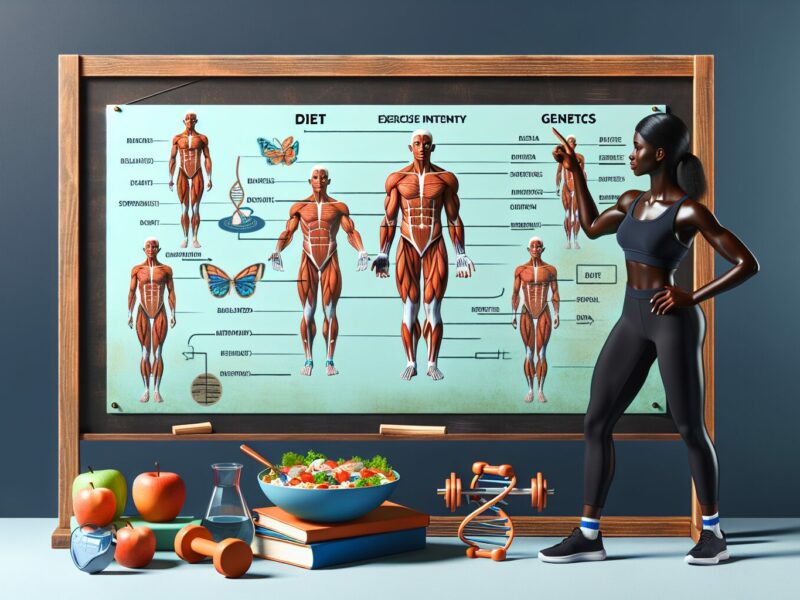Are you looking for ways to track your progress and measure your muscle mass? It’s important to keep tabs on your fitness journey to see how far you’ve come and set goals for the future. In this article, we will explore different methods and techniques you can use to track your progress and accurately measure your muscle mass. By following these tips, you’ll be able to stay motivated and continually make improvements in your fitness routine. So let’s get started and find out how you can effectively track your progress and measure your muscle mass.
Why Track Progress and Measure Muscle Mass
Tracking your progress and measuring your muscle mass are important components of any fitness journey. By monitoring your progress, you can see how far you’ve come and stay motivated to continue working towards your goals. Additionally, tracking muscle mass specifically allows you to gauge the effectiveness of your workouts and make adjustments to your training and nutrition plan as needed. Whether you are looking to build muscle, lose fat, or improve overall fitness, measuring your muscle mass can provide valuable insights and help you stay on track.

Methods for Tracking Progress and Measuring Muscle Mass
There are several methods you can use to track your progress and measure your muscle mass. Each method has its own advantages and considerations, so it’s important to choose the ones that work best for you and your goals. Let’s explore some of the most common methods below.
Weighing Yourself
One of the simplest methods for tracking your progress is by regularly weighing yourself. When using this method, it’s important to weigh yourself under consistent conditions, such as first thing in the morning, after using the bathroom, and without any clothing. By tracking your weight, you can get a general idea of whether you are gaining or losing overall mass. However, it’s important to remember that weight alone does not provide a complete picture of your body composition as it doesn’t distinguish between fat, muscle, and water weight.
Measuring Body Fat Percentage
Measuring your body fat percentage is another valuable method for tracking your progress and measuring muscle mass. Body fat percentage specifically quantifies the amount of fat in your body compared to your lean mass. There are several methods you can use to measure body fat percentage, including skinfold calipers, bioelectrical impedance analysis (BIA), dual-energy x-ray absorptiometry (DXA) scan, and air displacement plethysmography (Bod Pod). Each method has its pros and cons, so it’s important to choose the one that aligns with your preferences and availability.
Taking Measurements
Taking measurements of various body parts can provide insights into changes in muscle mass and overall body composition. Common measurements include circumference measurements of the arms, chest, waist, hips, and thighs. Additionally, calculating your body mass index (BMI) and waist-to-hip ratio (WHR) can give you a rough estimate of your overall health and body composition. Finally, measuring muscle girth can help you track specific muscle growth and changes over time.
Using Progress Photos
Progress photos can be a powerful visual tool for tracking your progress and measuring muscle mass. By taking consistent photos from the same angles and in the same lighting, you can compare and analyze changes in your physique over time. Progress photos can be especially beneficial for capturing aesthetic changes and muscle definition that may not be reflected in other tracking methods.
Tracking Strength and Performance
In addition to tracking physical changes, monitoring your strength and performance can also provide insights into your muscle mass and overall progress. By recording the number of repetitions and amount of weight you can lift, you can track improvements in strength over time. Similarly, monitoring the duration and intensity of your workouts can help you gauge whether you are making progress or plateauing. Tracking personal records and progression in exercises like squats, bench press, or deadlifts can provide concrete evidence of muscle mass gains.
Online Tools and Apps for Tracking Progress and Muscle Mass
With the rise of technology, there are now numerous online tools and apps available to help you track your progress and measure your muscle mass. Fitness trackers and wearable devices, such as fitness watches and smart scales, offer convenient ways to monitor weight, body fat percentage, and other metrics. These devices often come with corresponding apps that allow you to store and analyze your data. Additionally, there are dedicated fitness apps and software programs that offer comprehensive tracking features, including progress photos, strength tracking, and nutrition monitoring.
The Importance of Tracking Nutrition and Diet
While tracking your progress and measuring muscle mass is important, it’s crucial not to overlook the role of nutrition and diet in achieving your goals. Proper nutrition plays a significant role in muscle building, fat loss, and overall health. Tracking your nutrition and diet can help you identify areas for improvement, ensure you are consuming enough protein and other essential nutrients, and make necessary adjustments to support your muscle mass goals. Keeping a food diary, monitoring macros and micronutrients, and utilizing apps and online tools designed for nutrition tracking are helpful methods for staying on top of your dietary needs.
Conclusion
Tracking your progress and measuring your muscle mass are essential practices for anyone looking to achieve their fitness goals. By utilizing various methods such as weighing yourself, measuring body fat percentage, taking measurements, using progress photos, and tracking strength and performance, you can gain valuable insights into your progress and make informed decisions about your training and nutrition. Additionally, with the availability of online tools and apps, tracking progress and muscle mass has become more convenient and accessible than ever before. Remember, while measuring muscle mass is important, it’s equally crucial to pay attention to your nutrition and diet to optimize your results and overall health. So, start tracking your progress today and watch as your hard work pays off!

